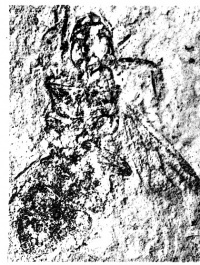Elaeomyrmex
| †Elaeomyrmex Temporal range: Late Eocene Florissant, Colorado, United States | |
|---|---|

| |
| Elaeomyrmex gracilis | |
| Scientific classification | |
| Kingdom: | Animalia |
| Phylum: | Arthropoda |
| Class: | Insecta |
| Order: | Hymenoptera |
| Family: | Formicidae |
| Subfamily: | Dolichoderinae (incertae sedis) |
| Genus: | †Elaeomyrmex Carpenter, 1930 |
| Type species | |
| Elaeomyrmex gracilis | |
| Diversity | |
| 2 fossil species (Species Checklist) | |
There are two fossil species in the genus Elaeomyrmex, both known from Florissant shale (Oligocene) in the United Sates. At this time Elaeomyrmex is incertae sedis within the Dolichoderinae.
Identification
Female.- Head much longer than broad, narrowed anteriorly, posterior margin straight or slightly rounded, posterior angles broadly rounded, lateral margins nearly straight; mandibles prominent, triangular, with a large terminal tooth and five or six smaller teeth on the inner margin; clypeus large, anterior margin apparently straight, posterior margin with a prominent, median prolongation; entire clypeus with a series of fine striations which converge anteriorly; scapes of moderate size, not quite reaching the anterior margin of the head; eyes oval, of moderate size, situated at about the middle of the sides of the head; ocelli well developed; thorax rather long, slender; petiole small, the scale flattened, highest anteriorly; gaster slender; forwing with two closed cubita cells. The whole insect has a peculiar greasy appearance, unlike that of any other of the Florissant ants.
Worker.- Much smaller than the female but essentially the same in structure, excpet for somewhat smaller eyes. Clypeus striated as in the female.
Distribution
This taxon is known from Florissant, Colorado, United States (Late Eocene).
Castes
Queens, ergatogynes, and workers known.
Nomenclature
The following information is derived from Barry Bolton's Online Catalogue of the Ants of the World.
- †ELAEOMYRMEX [incertae sedis in Dolichoderinae]
- †Elaeomyrmex Carpenter, 1930: 48. Type-species: †Elaeomyrmex gracilis, by original designation.
References
- Barden, P. 2017. Fossil ants (Hymenoptera: Formicidae): ancient diversity and the rise of modern lineages. Myrmecological News 24: 1-30.
- Bolton, B. 1994. Identification guide to the ant genera of the world. Cambridge, Mass.: Harvard University Press, 222 pp. (page 26, Elaeomyrmex in Dolichoderinae, Dolichoderini)
- Bolton, B. 1995b. A new general catalogue of the ants of the world. Cambridge, Mass.: Harvard University Press, 504 pp. (page 187, Elaeomyrmex in Dolichoderinae, Dolichoderini)
- Bolton, B. 2003. Synopsis and Classification of Formicidae. Mem. Am. Entomol. Inst. 71: 370pp (page 87, Elaeomyrmex in Dolichoderinae, Dolichoderini)
- Carpenter, F. M. 1930. The fossil ants of North America. Bulletin of the Museum of Comparative Zoology 70: 1-66 [1] (page 48, Elaeomyrmex in Dolichoderinae, Tapinomini)
- Shattuck, S. O. 1994. Taxonomic catalog of the ant subfamilies Aneuretinae and Dolichoderinae (Hymenoptera: Formicidae). Univ. Calif. Publ. Entomol. 112:i-xix, 1-241. (page 91, Elaeomyrmex in Dolichoderinae, Dolichoderini)
- Ward, P.S., Brady, S.G., Fisher, B.L. & Schultz, T.R. 2010. Phylogeny and biogeography of Dolichoderinae ants: effects of data partitioning and relict taxa on historical inference. Systematic Biology 59: 342-362 [2]
